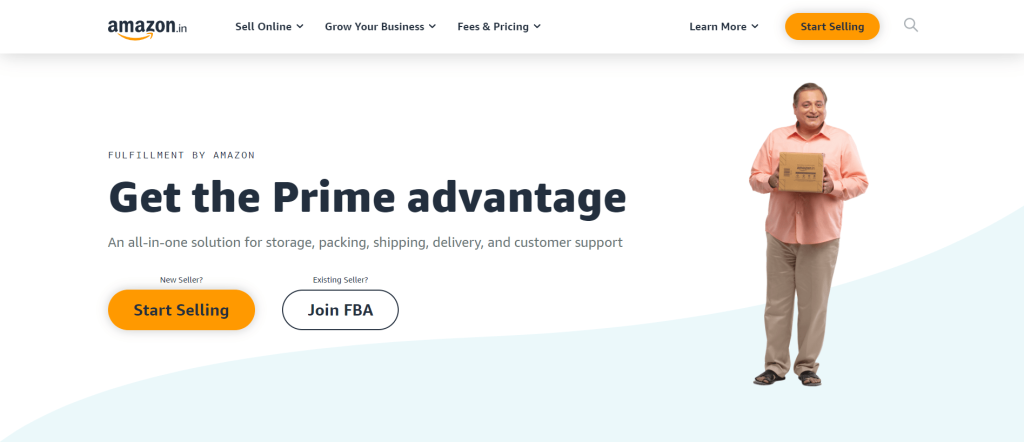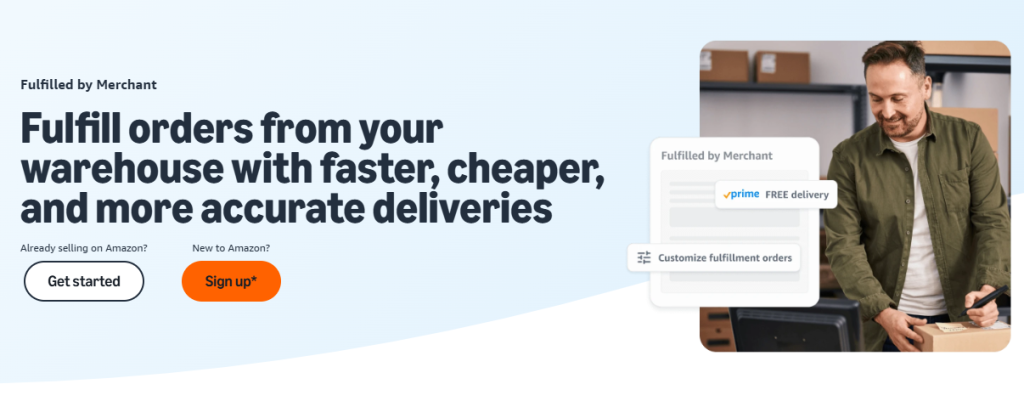The debate of Amazon FBA vs. FBM has been ongoing for some time. Both fulfillment methods have pros and cons that make them attractive to sellers looking to use Amazon as a platform for selling products.
In this article, we will go over the basics of each method, discuss the advantages and disadvantages, and explain why you might want to choose one over the other.
We’ll also cover storage fees, Prime shipping, and Seller-Fulfilled Prime so you can better understand how these methods work.
By the end of this article, you should have a good idea about which fulfillment method best suits your needs and allows you to easily sell on Amazon.
Let’s have a look.
Contents
- 1 FBA (Fulfillment by Amazon) Overview
- 2 FBM (Fulfillment by Merchant) Overview
- 3 Amazon FBA vs. FBM – A Complete Comparison Guide to Choosing Between the Two?
- 4 FBA Vs. FBM: Expenses and profits
- 5 Which One Is the Right Decision for Your Amazon Business?
- 6 Can I Use FBA and FBM at the Same Time?
- 7 Amazon FBA vs FBM – Pros & Cons
- 8 Final Verdict: Should Amazon Sellers Use FBA or FBM?
FBA (Fulfillment by Amazon) Overview
FBA, Fulfillment by Amazon, is a popular service by Amazon that helps users mainly with storage and shipping. In FBA, Amazon is responsible for complete order processing. FBA allows you to showcase your products on Amazon’s website while taking full responsibility for completing the order on your behalf.

As a seller, you must transport your inventory to Amazon warehouses, and Amazon takes over from thereon. Of course, there is a fee that you need to pay to acquire the FBA services.
In addition to order fulfillment, Amazon provides after-sales services such as returns, cancellations, and refunds. Customer service is also available for your customers, helping them with orders and other queries.
FBM (Fulfillment by Merchant) Overview
Amazon FBM or fulfillment by merchant agreement allows you to list your products on Amazon, similar to FBA, but in this model, the seller is supposed to process the order on his behalf.
This means you, as a seller, are responsible for storing the inventory, shipping the product to the customer, and handling everything concerning the order.

If you opt for an FBM seller agreement, you need the storage capacity and the shipping facility to deliver the orders.
Amazon FBA vs. FBM – A Complete Comparison Guide to Choosing Between the Two?
Although FBA is a rather popular choice amongst sellers, both of them have specific characteristics which make them better than the other. But ultimately, it depends on the nature of your business and your experience in the e-commerce environment.
With FBA, Amazon provides several facilities, such as a place to store your inventory. You only need to ship the products to the nearest Amazon warehouse. While in FBA, you must have space to store your goods. Since we know how costly renting or buying a place to store the material can be, FBA seems to be a better option.
Another key difference between the two models is that in FBA, Amazon takes care of everything concerning a customer order. Everything is done by Amazon teams, from picking up the item to delivering the order to the customer’s doorstep. This includes packaging, printing labels, shipping, etc.
With FBM, you need a proper fulfillment center with an infrastructure to process orders, packing, printing, and shipping. Order handling also required fetching and processing customers’ data and printing labels and invoices.
Regarding shipping the orders, with FBA, you don’t need to worry about shipping at all. Amazon uses its logistic partners’ services to ship and deliver orders. You need to transport your inventory to Amazon warehouses, and you need to pay for shipping costs.
With FBM, since the seller holds the inventory, you can ship the orders on your terms and duration. The seller can dictate his terms and conditions regarding delivery time and cost, return and refund policy, etc. However, it would be best if you also covered the shipping cost of the orders. You can utilize some of Amazon’s logistics partners for that.
FBA provides customers additional services such as an easy return and refund process, faster delivery, and customer care service. With FBA, you are responsible for customer service, return, and refund processing.
FBA Vs. FBM: Expenses and profits
There is a huge difference between FBA and FBM regarding the cost of usage and the profit it might generate for you.
With FBA, you pay a monthly subscription fee to Amazon and transport your inventory to the Amazon hub, and you are good to go. Amazon team takes over from there, and it’s their responsibility to sell your product on your behalf. You must also pay for the storage you will use in Amazon warehouses; sometimes, the storage cost might overwhelm you.
With FBM, you store your goods and ship the orders on your terms and conditions. Although you are paying no money to Amazon, you still need to rent/buy a place to store your goods and bear the shipping costs. Although you are not paying any money to Amazon, the cost of storage and shipping alone can hamper your budget badly.
With FBA, your products are listed in the Prime category, which means extremely lenient return policies and high return rates. Also, Amazon accepts returns even after the package has been opened and used for a limited period, and it might end up eating a chunk of your profit.
In the FBA agreement, you are in control of returns and refunds. The product doesn’t fall in the prime category, meaning no express deliveries. You can decide the delivery duration while listing your products, along with suitable return and refund policies. FBM somehow gives you more control in this segment of your business.
The cost of using both FBA and FBM is slightly different, but based on the nature of your business, each can significantly impact your profit. With FBA, a monthly subscription fee can’t be considered cheap.
Additionally, there are some hidden charges that you need to pay; for example, if you don’t sell your goods within the subscription period, you may be asked to pay a long-term, expensive fee to continue using Amazon storage. Also, in case of damage to your inventory, Amazon asks you to pay the fee to discard the damaged/faulty products from its warehouse.
But if you consider everything, your product is listed in the Prime category, which means customers are more likely to choose your items over others since Amazon Prime is a symbol of quality services nowadays.
Regarding FBM, yes, you don’t need to pay any fee to Amazon. Still, it would help if you had a well-established origination-level business to fulfill the orders and logistics service to ship them. It would help if you were also trained staff to process the orders, printing and packaging, and customer services since you are in charge of everything here.
Which One Is the Right Decision for Your Amazon Business?
Now the important question is, which seller service is perfect for you? Most of the Amazon sellers would advise you to go for an FBA agreement rather than FBM, and to be honest, it’s not surprising at all. You attract more customers due to the Prime label; your orders get delivered under the Amazon brand name, resulting in delighted customers. And you don’t need to hire staff to handle order processing, customer care service, etc.
If your business allows you to cover the FBA charges, you are better off with this agreement since you don’t need a big storage place, a big staff, shipping facilities, etc.
However, if you own a well-established business with a fulfillment facility, FBM is the right choice. FBM gives you more flexibility while listing your items, storing the inventory, and shipping the orders. Remember that you need to have a well-trained staff with some experience in order processing, and the shipping cost can sometimes be very high since you may need to use air freight.
Can I Use FBA and FBM at the Same Time?
You can simultaneously use FBA (Fulfillment by Amazon) and FBM (Fulfillment by Merchant). FBA is a service provided by Amazon that allows you to store your products in their warehouses and have them shipped directly to customers. FBM, on the other hand, involves merchants storing their products and shipping them to customers.
Using both services together can give you flexibility when fulfilling orders. You can choose which orders you want to fulfill yourself and which you want Amazon to take care of. This way, you can save on shipping costs while providing an excellent customer experience.
Additionally, using multiple fulfillment methods gives customers more options when ordering from your online store, allowing them to choose whichever method works best for them.
Amazon FBA vs FBM – Pros & Cons
Let’s have a look at pros and cons of FBA and FBM
Amazon FBM: Pros and Cons
Pros of Amazon FBM (Fulfillment by Merchant):
- Lower fees compared to Amazon FBA (Fulfillment by Amazon)
- Greater control over product pricing and branding
- Ability to ship products to customers directly from your warehouse or storage facility
Cons of Amazon FBM:
- More responsibility for handling, packaging, and shipping of products
- Lack of Prime eligibility for FBM products
Amazon FBA: Pros and Cons
Pros of Amazon FBA:
- Amazon handles all aspects of fulfillment, including shipping, customer service, and returns
- Eligibility for Prime shipping and the Buy Box, which can increase sales
- Access to Amazon’s network of warehouses and distribution centers for faster shipping times
- Reduced need for customer service and support
Cons of Amazon FBA:
- Higher fees for fulfillment and storage
- Limited control over product pricing and branding
- Potential for lost or damaged inventory due to Amazon’s handling and storage process.
- Amazon’s return policy may be stricter than merchants’ return policies.
Related Read:
Final Verdict: Should Amazon Sellers Use FBA or FBM?
There you go. This analysis will clear the differences between FBA and FBM. There is no definite winner between the two when compared head-to-head. Ultimately, it all depends on your budget, resources, and personal preference. Most sellers suggest you go with FBA since it’s a safer option with lower requirements and offers a better opportunity to expand your footfall on the Amazon market.
- If you don’t have experience in order fulfillment and don’t have enough resources to do so, FBA is the way to go. Starting is less expensive, and Amazon handles most of your work. So if you are a small business with no resources, check out FBA prices and work your way from thereon.
- If you want more control over your customers and order fulfillment, such as packaging, delivery time, charges, etc., you should go with FBM. Remember that you need the resources to fulfill the orders and the storage capacity to hold the inventory. This might cost you a chunk of money, but y
Frequently Asked Questions
FBA is better than FBM because the seller doesn’t need to pay for shipping the orders and other facilities such as customer care, packaging, printing labels, etc. With FBA, you pay a monthly subscription fee to Amazon, transport your inventory to the Amazon hub, and Amazon takes care of the orders from thereon.
The main difference between FBA and FBM is the order processing. With FBA, the seller can use Amazon resources to ship the orders to its customers, while in FBM, the seller has to process the orders along with the shipping facility.
It depends on the type of your business. If you have a big business with a fulfillment facility and big enough storage, FBM might prove profitable, while FBA is more suitable for smaller businesses.
It’s not very easy to break into the Amazon business. You need to have a detailed market study and your product. For a better idea, you can use one of the Amazon seller tools available on the market, such as Jungle Scout or Helium 10.
Another option is Seller-Fulfilled Prime. It’s the same as FBM, but it allows you to display your products in the Prime category, but you must be able to fulfill the order within Amazon Prime requirements.

I’m a professor, serial entrepreneur and e-commerce expert with a passion for creating successful online business models. After achieving huge success in the Amazon FBA business, I decided to make it my mission to help my fellow sellers do the same through enjoy-aiia.com .
